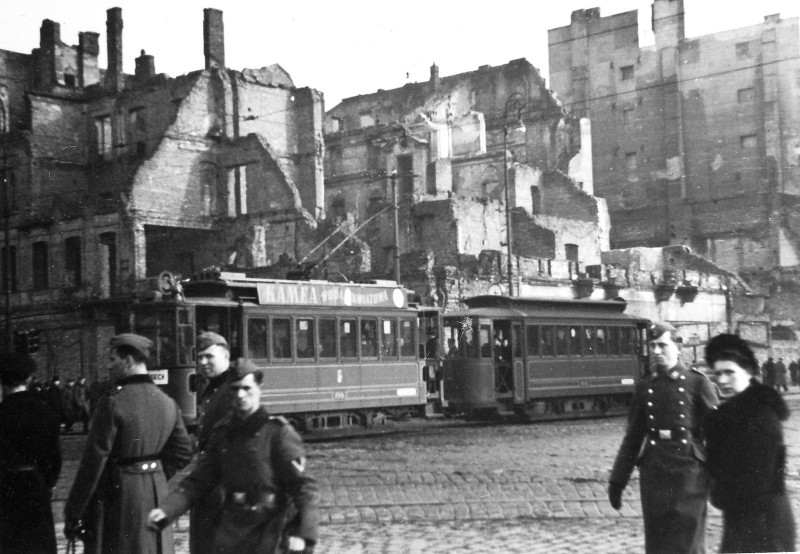When do you think this photo was taken?
About This Photo:
During the German occupation of Warsaw in World War II, the city was a place of tremendous hardship, resilience, and profound change. One of the most striking images from this period can be found at the intersection of Marszalkowska Street and Aleje Jerozolimskie Street, where the ruins of a once-thriving urban area stood in stark contrast to the remnants of the past. A photograph from this time captures a moment frozen in history: tram #3 passing by a billboard reading "Kamea woda kwiatowa," with the ruins of a townhouse at Marszalkowska 98 and Aleje Jerozolimskie 33 in the background, reflecting the devastation of the city after the September 1939 invasion.
A City Transformed by War
Before the war, Marszalkowska and Aleje Jerozolimskie were two of Warsaw's most significant streets, bustling with commerce, culture, and daily life. Marszalkowska, known for its grand buildings and vibrant atmosphere, was a key thoroughfare through the city. Aleje Jerozolimskie, another major street, connected the city center with the western suburbs and had long been an area of importance for both residential and commercial purposes.
However, the German invasion in September 1939, and the subsequent occupation of Warsaw, brought about a dramatic transformation. Buildings were reduced to rubble, infrastructure was severely damaged, and the daily rhythms of life were upended. The intersection of Marszalkowska and Aleje Jerozolimskie became a symbol of this change, as the ruins of buildings like the townhouse at Marszalkowska 98 and Aleje Jerozolimskie 33 stood as haunting reminders of the destruction inflicted upon the city.
The Trams and the Billboard
Amidst the devastation, some aspects of daily life continued, albeit under much more difficult circumstances. In the photograph, tram #3 appears to be in motion, symbolizing the persistence of public transportation in a war-torn city. Trams had long been an essential part of Warsaw’s transportation network, and despite the occupation, they remained operational, albeit under strict German control.
The tram’s route, visible in the photograph, was a key part of the city's movement, carrying people through the streets even as the city was slowly being rebuilt. The presence of the "Kamea woda kwiatowa" billboard adds another layer of intrigue to the scene. The sign, advertising a floral water product, is a reminder of the pre-war commercial life in Warsaw, juxtaposed against the devastation surrounding it. Its appearance in the photo highlights the strange resilience of everyday commerce, even in the midst of warfare.
Rebuilding Warsaw After the War
The ruins behind the tram were not just physical remnants of destruction; they were also symbols of the profound loss and suffering experienced by the residents of Warsaw. The townhouse at Marszalkowska 98 and Aleje Jerozolimskie 33 was just one of many buildings reduced to rubble during the invasion, and it stood as a painful reminder of the civilian toll of the war. After the war, Warsaw faced the monumental task of rebuilding, and much of the city’s pre-war architecture was lost forever.
The intersection of Marszalkowska and Aleje Jerozolimskie, like many other parts of the city, would eventually be restored. However, the scars left by the war remained, etched into the city's fabric and collective memory. The photograph of this moment in time, with the tram and the ruined buildings, serves as both a tribute to the resilience of Warsaw’s residents during the occupation and a poignant reminder of the destruction that war brings.
In the years following the war, Warsaw would rise from the ashes, slowly restoring its streets and rebuilding its history. Yet, the images of this devastated intersection will forever remain a powerful symbol of the war's impact on Warsaw and its people.

